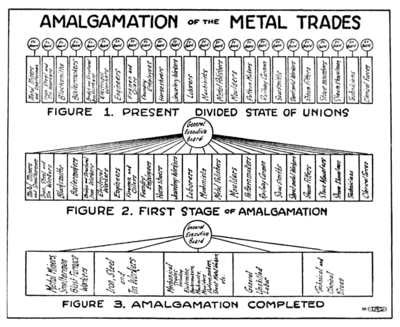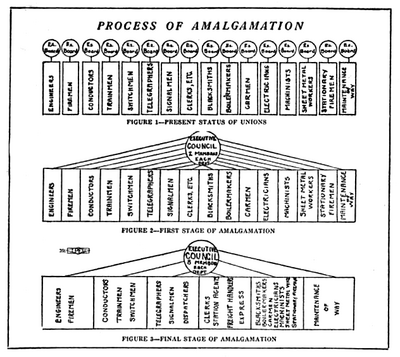Amalgamation/Chapter 5
CHAPTER V.
Departmentalized Industrial Unionism
A COMMON objection to amalgamation is the argument that the industrial union will throw ali the workers together in a general mass, eliminating craft identity and thus creating a confusion and general indifference among the rank and file that will weaken rather than. strengthen the organization. This would, indeed, be a vital objection were it true, But all over the world-where such industrial unions exist they are formed on the basis of departments, each of which contains several closely-allied crafts. The League is urging this same form here. In each industry there will be one organization covering the whole body of workers, but this will be sub-divided into sections or departments for the principal branches of the industry. This will enable the respective trades to handle their particular problems efficiently and at the same time benefit from the strength of the whole mass.
Thus, far from being a confused mixture, the departmentalized industrial union will be a system of perfect order. Each department will handle its own line of work efficiently, and all departments will be blended together in the general organization through their representatives on the national executive board. Compared with this modern system of organization the present craft. unions, each going its separate way and duplicating the union work of the industries as many as thirty times, is confusion worse confounded. The departmentalized union will be like an army, with its separate branches of artillery, cavalry, infantry, etc., but all welded together into one powerful machine.
Under the industrial system of unionism the workers will obtain tremendous power compared with the craft or federated form. Unity of action will at all times be obtainable. There will be no craft or departmental strikes without the absolute assurance that the whole industrial union stands solidly behind them with the combined strength of all. The painful spectacle of unions going down to defeat before the onslaughts of combined capital, while allied unions stand by with seeming indifference and give their fallen brothers no helping hand, will be a thing of the past, Such preposterous unionism will be buried so deep it will never be revived except in scornful memory. It will then be difficult to imagine that the workers ever had such short-visioned, narrow-minded, self-centered unionism, as our present system.
Advantages of Industrial Unionism
With the advent of departmentalized industrial unionism will come many advantages. One will be the end of the dual union scourge. Once industrial unionism is established all the workers, regardless of their other differences, will gravitate to the powerful organizations. Likewise great financial economies will be made. The amount of money and time wasted through the duplication of offices, officials, journals, conventions, etc., in our craft unions is appalling, Let us consider the metal industry as an example. In that great industrial division there are 24 International Unions, maintaining 24 expensive headquarters, with 24 high-salaried presidents, and 24 high-salaried secretaries to adorn them. They publish 24 costly journals, and have 24 international executive boards that keep the industry going 24 ways and getting nowhere. They have 24 sets of organizers and their combined work totals less than 10% of the total workers in the industry. They hold 24 separate conventions, each one of which costs the workers large sums of money. They have thousands of duplicate sets of local officers, business agents, etc., at a tremendous cost. When these 24 unions are amalgamated all this wasteful duplication will be abolished by the introduction of an efficient system of modern management. There will be but one headquarters, one set of officers, one journal, and one convention. Where chaos and wastefulness now exist, then there will be order and economy. By combining their plants the masters of industry cut out such foolish wastefulness many years ago. It is high time that Labor did the same.
But above all, departmentalized industrial unionism will give the workers the power they now so badly need. The enormous strength that the industrial unions will have is the big idea behind amalgamation. At present the 24 metal trades unions, for example, are weak and impotent through their hopeless division. But once they unite and make a general assault on the "open shop" employers, headed by the Steel Trust, they will be invincible. The same will be true of the unions in the other industries. The capitalists rule not so much because they are strong as because we are weak. When Labor learns to rise above its petty craft point of view and to draw itself into great industrial batallions, then the domination of the exploiters will be doomed. The next great step in the workers' march to industrial freedom is the formation of great departmentalized industrial unions in every industry.
An Orderly Change
Amalgamation will proceed in an orderly fashion. There need be no violent disturbance of the existing organizations, with their long-established customs, dues systems, etc. The process can go ahead in a steady progress, The first step in amalgamating the unions of an industry will be to call a convention of all the unions agreeing to amalgamate. These will resolve themselves into an industrial union, and elect a general executive board to which all the unions taking part turn over their international business. For the time being all these unions will remain practically intact, each one becoming a department in the amalgamated union. When other unions decide to come in they simply elect their quotas of delegates to the general executive board and take their places as departments in the big union. The proposition is simplicity itself. There is no suggestion of throwing the crafts together in a confused mass.
This first step, by joining the unions under one head, accomplishes the main aim of amalgamation by actually uniting the workers' forces. Later on, when the workers come to thoroughly appreciate the value of industrial organization, the final stage of amalgamation can be accomplished by a gradual standardization of dues and benefits systems, and by a reduction in the number of departments. In the metal trades, for example, the 24 craft departments will eventually be reduced to five, in about the following order: Department No. 1, to include metal miners, smeltermen, and blast-furnace workers; No. 2, iron, steel, and tin workers; No. 3, mechanical trades; No. 4, unskilled workers; No. 5, technical and clerical workers. In the railroad industry the 16 crafts will eventually be cut to six departments, as follows: No. 1, engineers and firemen; No. 2, conductors, brakemen, and switchmen; No. 3, telegraphers, signalmen, and dispatchers; No. 4, clerks, station agents, freight handlers, express and baggagemen; No. 5, boilermakers, blacksmiths, machinists, electricians, carmen, sheet metal workers, stationary firemen; No. 6, maintenance of way workers. The same principle will apply to the other industries. With such departmentalized unions, the organized workers will be incomparably better fitted to develop their full strength for the tasks in hand, whether these be the organ-

Diagram Showing the Process of Amalgamation in the Metal Trades, Creating a Departmentalized Industrial Union
To the superficial observer amalgamation of the 16 standard railroad unions is the most critical of all the problems of the industrialists. Many assert it to be quite impossible, due on the one hand to the great differences in the amounts of dues paid by the members of the various unions, and on the other hand to the fact that there are six unions employed in the railroad service that are not basically railroad organizations. But both of these problems are capable of easy solution once there is a real determination to amalgamate. Industrial

Diagram Showing the Process of Creating a Departmentalized Industrial Union Through Amalgamation in the Railroad Industry
As for the dues problem, that is readily solved through the departmental system. In each department, if necessary, different scales of dues and benefits can prevail. It is merely a technical problem such as has been worked out by every life insurance company in the country. As for the unions that are not entirely railroad organizations, the solution for them is that they will be affiliated two ways. The machinists, for example, will be affiliated to the metal trades industrial union, and also to the railroad union, paying part of their dues to each organization. The railroad union, in order to secure united action of the railroad workers, will have control of the strike activities of the railroad machinists. This system of double affiliation has been worked out by many big unions and proves thoroughly satisfactory. There is no need nor intention to split the railroad metal trades in order to bring about an industrial union of railroad workers.
The departmental plan of industrial unionism will be adopted in all the industries, because it is the only scientific method of defending the interests of the workers. It is the result of a crying need for a system of organization that will meet the demands of modern industrial evolution. The old clumsy method of each craft fighting its own battle is as much out of place as would be an ox-cart service in competition with modern railroads. Whether in the matter of economy and efficiency of administration, or in the defense of the workers' interests, departmentalized industrial unionism is incomparably superior to our present primitive and outworn craft organizations.
The Test of Experience
The system of departmentalized industrial unionism, as above outlined, is not a new and untried theory by any means. Our European brothers, who are far ahead of us in the matter of tactics and organization, have had such industrial unions for many years. For a long time they have been amalgamating their original craft unions into departmentalized bodies, with most satisfactory results. The English railroad workers show us a very fine example in their National Union of Railwaymen. This amalgamated union embraces all classes of railroad workers. It is divided into four departments which, giving the various crafts ample representation, function with harmony, order, efficiency, and service as their outstanding features. Since its formation upon the departmental plan in 1913, the N. U. R. has made remarkable progress in combining the railroad workers of Great Britain. Other samples of this type of union are the Transport and General Workers' Union, the Amalgamated Engineers' Union, and the Federation of Building Trades Operatives.
In Germany, industrial unionism has reached a higher degree of development than anywhere else. The Metal Workers' Union is the largest industrial union in the world. It has a membership of 1,800,000, and it covers all branches of the metal industry. It has numerous departments through which all the different trades function and have their being as integral parts of the big whole. The entire departmental system of this giant combination of metal workers operates with smoothness and efficiency. The Metal Workers' Union was constructed by a series of amalgamations of primitive craft unions that once struggled along individually as our own are still doing. In Austria the workers have declared for the combination: of their craft unions into industrial organizations, and in Australia this is now a practical fact. Twelve industrial unions contain about all the workers of Belgium. The Scandinavian workers are re-adjusting their craft unions upon an industrial basis. The work of amalgamation is going on all over the world. Only in America is it lagging.
The American capitalists lead the world for enterprise, daring, and militant progressiveness. The American labor movement leads the world in the opposite directions. It is fully 30 years behind the times in its ideas and organization structure. Its officialdom has persistently remained capitalistic and has tied the labor unions to the chariot of industrial despotism, This bond must be broken and Labor released from the thralldom of capitalist thought by the sturdy militants who are now assembling under the banner of the Trade Union Educational League. The accomplishment of departmentalized industrial unionism through amalgamation is the first and most important step in this great work of emancipation.
